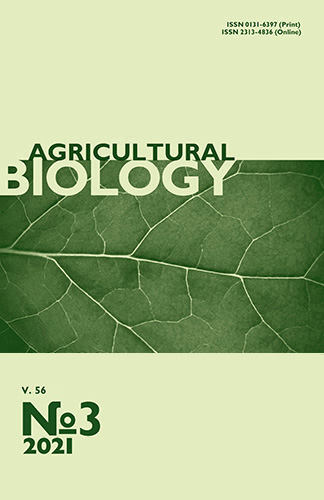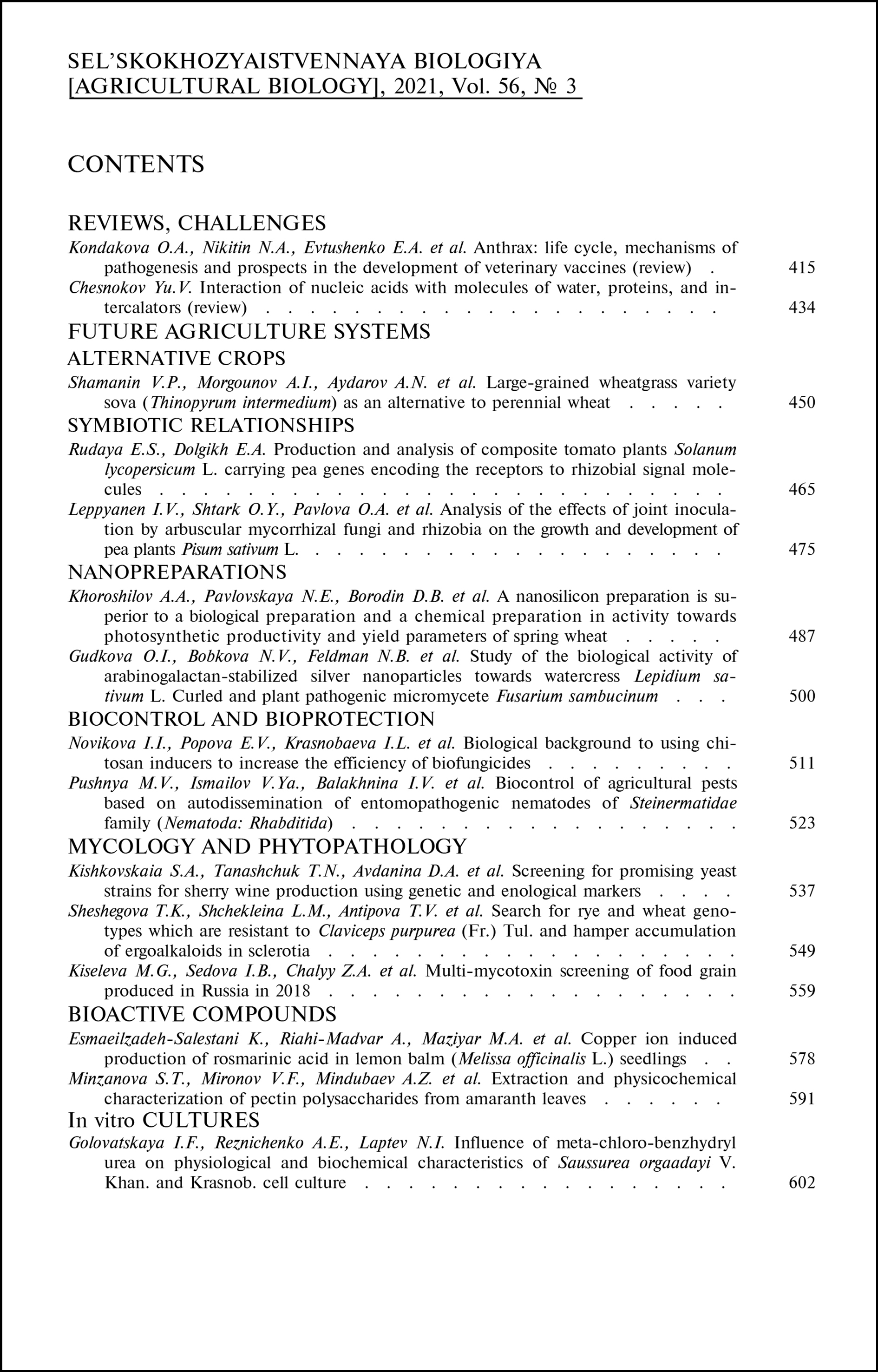doi: 10.15389/agrobiology.2021.3.591eng
UDC: 582.663.2:581.19:547.458.88
EXTRACTION AND PHYSICOCHEMICAL CHARACTERIZATION OF PECTIN POLYSACCHARIDES FROM AMARANTH LEAVES
S.T. Minzanova1 ✉, V.F. Mironov1, A.Z. Mindubaev1, O.V. Tsepaeva1, L.G. Mironova1, V.A. Milyukov1, V.K. Gins2, M.S. Gins2, P.F. Kononkov2, V.M. Babayev1, V.F. Pivovarov2
1Arbuzov Institute of Organic and Physical Chemistry, FRC Kazan Scientific Center RAS,8, ul. Arbuzova, Kazan, Republic of Tatarstan, 420088 Russia, e-mail minzanova@iopc.ru (corresponding author ✉), mironov@iopc.ru, mindubaev-az@yandex.ru, tsepaeva@iopc.ru, liubov.mironova@iopc.ru, miluykov@iopc.ru, babaev@iopc.ru;
2Federal Research Center for Vegetable Growing, 14, ul. Selektsionnaya, pos. VNIISSOK, Odintsovskii Region, Moscow Province, 143080 Russia, e-mail anirr@bk.ru, anirr67@yandex.ru, pivovarov@vniissok.ru
ORCID:
Minzanova S.T. orcid.org/0000-0001-9678-8821
Gins V.K. orcid.org/0000-0002-7053-4345
Mironov V.F. orcid.org/0000-0002-4198-3774
Gins M.S. orcid.org/0000-0001-5995-2696
Mindubaev A.Z. orcid.org/0000-0002-8596-7805
Kononkov P.F. orcid.org/0000-0001-7101-3528
Tsepaeva O.V. orcid.org/0000-0003-0952-0486
Babayev V.M. orcid.org/0000-0002-3918-7031
Mironova L.G. orcid.org/0000-0002-2176-1090
Pivovarov V.F. orcid.org/0000-0003-1350-5852
Milyukov V.A. orcid.org/0000-0002-8069-457X
Received April 24, 2021
Polysaccharides are one of the most important classes of natural compounds that have practical application in various fields of science and technology. Pectin remains one of the most essential polysaccharides, being a primary constituent of the structural elements of the cell wall in higher plants, performs the functions of binding and strengthening components of the cell wall, and also regulates water metabolism. Pectic substances are widely used in medicine as detoxicants of heavy metals and regulators of metabolic processes in the human body. In addition, they are also a universal food additive (E440). Despite significant amounts of traditional raw material resources (apple and citrus pomace, beet pulp), new alternative sources of raw materials are being searched for, including vegetable plants introduced in Russia for the production of pectins and their use in the production of functional foods. Among non-traditional plant resources, amaranth (Amaranthaceae) holds a significant rank. Due to its high yield and high content of biologically active substances and antioxidants, this crop acts as a potential source of obtaining valuable plant-derived substances for medicine, agriculture and the food industry. The Amaranthus tricolor L. cv. Valentina plants were used to isolate pectic substances by the classical method and ultrasonic treatment at a frequency of 22 kHz. Sugars were quantified using a Shimadzu 20-AD Prominence liquid chromatograph (Shimadzu Corporation, Japan) with a Shimadzu RID-10A refractometric detector. Infrared spectra were recorded on an IRS-113 instrument (Bruker, Germany) with a resolution of 1 cm-1 in the range 400-4000 cm-1. The elemental composition was determined (a CHNSO-high-temperature analyzer Euro EA 3028-HT-OM, EuroVector Instruments & Software, Italy). All measurements by atomic force microscopy (AFM) were carried out on a Multi Mode V scanning probe microscope (Veeco Instruments, Inc., USA) in an intermittent contact mode. Structural study of the isolated polysaccharides by the IR spectroscopy method showed their possible affiliation to pectin substances. To study the monosaccharide composition, the samples of pectins were hydrolyzed with sulfuric acid (2 N) and partially hydrolyzed with trifluoroacetic acid (TFA). The high-performance liquid chromatography (HPLC) identified glucose, galactose, rhamnose, arabinose and galacturonic acid in the pectin fractions. Low galacturonic acid contents of 0.63 % and 1.68 % were determined in H2SO4 and TFA hydrolyzates, respectively. The conditions for hydrolysis-extraction which ensure the maximum yield of pectin substances were 0.5 % oxalic acid with complexone (0.5 % HDTA), 50-55 °С, 4 h, feed to extractant volume (hydromodule) ratio of 1:15. The physicochemical properties of pectin obtained under these conditions were studied using atomic force microscopy (AFM) and thermogravimetric/differential scanning calorimetry (TG/DSC) methods. After ethanol re-precipitation, this pectin sample showed an intense absorption band of stretching vibrations of carbonyls of carboxyl groups and ester groups at 1742 cm-1. The TG/DSC indicated a two-step weight loss. The Fourier-transform infrared (FTIR) spectrum of the gaseous products derived from thermal decomposition of pectin sample showed that water was the main component of the gas phase at the first stage of weight loss and at the second stage, pectin was decarboxylated. According to atomic force microscopy, the size of the aggregates was 2.4-2.5 μm maximum and ~ 330 nm minimum.
Keywords: Amaranthus tricolor L., amaranth, cv. Valentina, hydrolysis-extraction, ultrasonic disintegrator, pectin, IR spectroscopy, pectin thermostability, TG/DSC, AFM.
REFERENCES
- Komissarenko S.N., Spiridonov V.N. Rastitel'nye resursy, 1998, 34(1): 111-119 (in Russ.).
- Samout N., Bouzenna H., Dhibi S., Ncib S., ElFeki A., Hfaiedh N. Therapeutic effect of apple pectin in obese rats. Biomedicine & Pharmacotherapy, 2016, 83: 1233-1238 CrossRef
- Yuliarti O., Goh K.K.T., Matia-Merino L., Mawson J., Brennan Ch. Extraction and characterisation of pomace pectin from gold kiwifruit (Actinidia chinensis). Food Chemistry, 2015, 187: 290-296 CrossRef
- Methacanon P., Krongsin J., Gamonpilas C. Pomelo pectin: effects of extraction parameters and its properties. Food Hydrocolloids, 2014, 35: 383-391 CrossRef
- Minzanova S.T., Mironov V.F., Konovalov A.I., Vyshtakalyuk A.B., Tsepaeva O.V., Mindubaev A.Z., Mironova L.G., Zobov V.V. Pektiny iz netraditsionnykh istochnikov: tekhnologiya, struktura, svoistva i biologicheskaya aktivnost' [Pectins from unconventional sources: technology, structure, properties, and biological activity]. Kazan', 2011 (in Russ.).
- Gins M., Gins V., Momyleva, S., Kulikov I., Medvedev S., Kononkov P., Pivovarov V. Mineral composition of amaranth (Amaranthus L.) seeds of vegetable and grain usage by ARHIVBSP selection. Potravinarstvo Slovak Journal of Food Sciences, 2018, 12(1): 330-336 CrossRef
- Vysochina G.I. Khimiya rastitel'nogo syr'ya, 2013, 2: 5-14 (in Russ.).
- Magomedov I.M. Uspekhi sovremennogo estestvoznaniya, 2008, 5: 57-59 (in Russ.).
- Ovodov Yu.S. Acta Naturae, 2010, 2(5): 29-37 (in Russ.).
- Caselato-Sousa V.M., Amaya-Farfán J. State of knowledge on amaranth grain: a comprehensive review. Journal of Food Science, 2012, 77(4): R93-R104 CrossRef
- Fritz M., Vecchi B., Rinaldi G.Yu., Añón M.C. Amaranth seed protein hydrolysates have in vivo and in vitro antihypertensive activity. Food Chemistry, 2011, 126(3): 878-884 CrossRef
- Orsini Delgado M.C., Tironi V.A., Anon M.C. Antioxidant activity of amaranth protein or their hydrolysates under simulated gastrointestinal digestion. LWT — Food Science and Technology, 2011, 44(8): 1752-1760 CrossRef
- Mendonça S., Saldiva P.H., Cruz R.J., Arêas J.A.G. Amaranth protein presents cholesterol-lowering effect. Food Chemistry, 2009, 116(3): 738-742 CrossRef
- Silva-Sánchez C., Barba de la Rosa A.P., Leon-Galván M.F., De Lumen B O., De Leon-Rodríguez A., González de Mejía E. Bioactive peptides in amaranth (Amaranthus hypochondriacus) seed. Journal of Agricultural and Food Chemistry, 2008, 56(4): 1233-1240 CrossRef
- Quiroga A.V., Barrio D.A., Anon M.C. Amaranth lectin presents potential antitumor properties. LWT — Food Science and Technology, 2015, 60(1): 478-485 CrossRef
- Ofitserov E.N., Kostin V.I. Uglevody amaranta i ikh prakticheskoe ispol'zovanie /Pod redaktsiei Yu.S. Ovodova [Amaranth carbohydrates and their practical use]. Ul'yanovsk. 2001 (in Russ.).
- Minzanova S.T., Mironov V.F., Vyshtakalyuk A.B., Tsepaeva O.V., Mironova L.G., A.I. Konovalov. Pectic polysaccharides from the plant Amaranthus cruentus. Water-soluble complexes of amaranth pectin with macro- and microelements. Russian Chemical Bulletin, 2014, 63(9): 2142-2155 CrossRef
- Pivovarov V.F., Gins M.S., Gins V.K. Innovative beverage production technologies based on Amaranth biomass. IOP Conference Series: Earth and Environmental Science, 2019, 395: 012090 CrossRef
- Gins M.S., Gins V.K., Motyleva S.M., Kulikov I.M., Medvedev S.M., Pivovarov V.F., Mertvishcheva M.E. I Metabolites with antioxidant and protective functions from leaves of vegetable amaranth (Amaranthus tricolor L.). Sel'skokhozyaistvennaya biologiya [Agricultural Biology], 2017, 52(5): 1030-1040 CrossRef
- Sarkar R., Nandan C.K., Mandal S., Patra P., Das D., Islam S.S. Structural characterization of a heteropolysaccharide isolated from hot water extract of the stems of Amaranthus tricolor Linn. (Amaranthus gangeticus L.). Carbohydrate Research, 2009, 344(17): 2412-2416 CrossRef
- Filippov M.P. Practical infrared spectroscopy of pectic substances Author links open overlay panel. Food Hydrocolloids, 1992, 6(1): 115-142 CrossRef
- Nahar K., Kabir F., Islam P., Rahman Md.M., Al Mamun Md.A., Faruk Md., Subhan N., Rahman G.M.S., Reza H.M., Alam Md.A. Cardioprotective effect of Amaranthus tricolor extract in isoprenaline induced myocardial damage in ovariectomized rats. Biomedicine & Pharmacotherapy, 2018, 103: 1154-1162 CrossRef
- Jiménez-Aguilar D.M., Grusak M.A. Minerals, vitamin C, phenolics, flavonoids and antioxidant activity of Amaranthus leafy vegetables. Journal of Food Composition and Analysis, 2017, 58: 33-39 CrossRef
- Cho E.-H., Jung H.-T., Lee B.-H., Kim H.-S., Rhee J.-K., Yoo S.-H. Green process development for apple-peel pectin production by organic acid extraction. Carbohydrate Polymers, 2019, 204: 97-103 CrossRef
- Golubev V.N., Shelukhina N.P. Pektin: khimiya, tekhnologiya, primenenie [Pectin: chemistry, technology, practical use]. Moscow, 1995 (in Russ.).
- Golbargi F., Taghi Gharibzahedi S.M., Zoghi A., Mohammadi M., Hashemifesharaki R. Microwave-assisted extraction of arabinan-rich pectic polysaccharides from melon peels: optimization, purification, bioactivity, and techno-functionality. Carbohydrate Polymers, 2021, 256: 117522 CrossRef
- Maran J.P., Swathi K., Jeevitha P., Jayalakshmi J., Ashvini G. Microwave-assisted extraction of pectic polysaccharide from waste mangopeel. Carbohydrate Polymers, 2015, 123: 67-71 CrossRef












